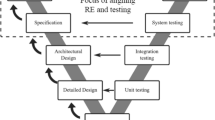Abstract
To be certain that prerelease reliability and performance levels can be expected in operation, one must establish that the testing environment emulates the end-use environment. If these environments differ, then one must know the nature of this difference to know its impact on customer satisfaction. While an ability to differentiate software environments is important in software engineering, there are few publications regarding this concept. Of the publications that we know of, none provide an empirical setting for comparing environments. In this paper we analyse two software systems as they operate in selected environments. We present two graphical characterizations of these systems, and we apply a statistical method to determine whether two environments are distinct. The results suggest applications of statistical methods in the detection of environmental differences.
Similar content being viewed by others
References
Ehrlich, W.K., Stampfel, J.P. and Wu, J.R. Application of software reliability modeling to product quality and test process, in Proceedings of the International Conference on Software Engineering, Nice, France, March 1990, pp. 108–116.
Musa, J.D., Iannino, A. and Okumoto, K. Software Reliability: Measurement, Prediction, Application (McGraw-Hill, New York, 1987).
Musa, J.D. Reduced operation software. Software Engineering Notes, 16, (1991) 78.
Abramson, S.R., Juhlin, B.D., Jensen, B.D. and Spudic, C.L. Customer satisfaction based product development, in Proceedings of the International Switching Symposium, Yokohama, Japan, October 1992, 2, pp. 65–69.
Musa, J.D. Operational profiles in software reliability engineering. IEEE Software, 10(2), (1993) 14–32.
Lamport, L. A Document Preparation System, LaTeX: User's Guide and Reference Manual (Addison-Wesley, Reading, MA, 1985).
Kernighan, B.W. and Ritchie, D.M. The C Programming Language (Prentice-Hall, Englewood Cliffs, NJ, 1978).
Graham, S.L., Kessler, P.B. and McKusick, M.K. An execution profiler for modular programs. Software-Practice and Experience, 13, (1983) 671–685.
Jain, R. The Art of Computer Systems Performance Analysis (John Wiley, New York, 1991).
Johnson, R.A. and Wichern, D.W. Applied Multivariate Statistical Analysis (Prentice Hall, Englewood Cliffs, NJ, 1992).
Khoshgoftaar, T.M. and Woodcock, T.G. Software reliability model selection. Quality and Reliability Engineering International, 8, (1992) 457–469.
Kaaniche M. and Kanoun K. The discrete time hyperexponential model for software reliability growth evaluation, in Proceedings of the Third IEEE International Symposium on Software Reliability Engineering, Raleigh, NC, October 1992, pp. 64–75.
Wall, D.W. Predicting program behavior using real or estimated profiles, in Proceedings of the ACM SIGPLAN Conference on Programming Language Design and Implementation, Toronto, Ontario, Canada, June 1991, pp. 59–70.
Author information
Authors and Affiliations
Rights and permissions
About this article
Cite this article
Khoshgoftaar, T.M., Lanning, D.L. Analysis and differentiation of software system environments. Software Qual J 5, 127–139 (1996). https://doi.org/10.1007/BF00419776
Issue Date:
DOI: https://doi.org/10.1007/BF00419776




